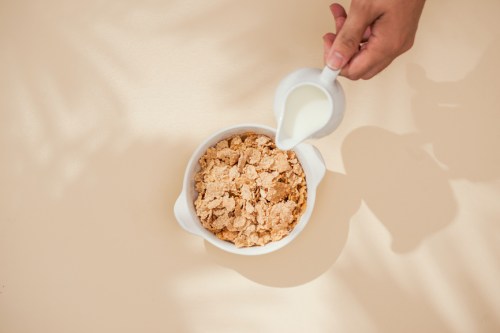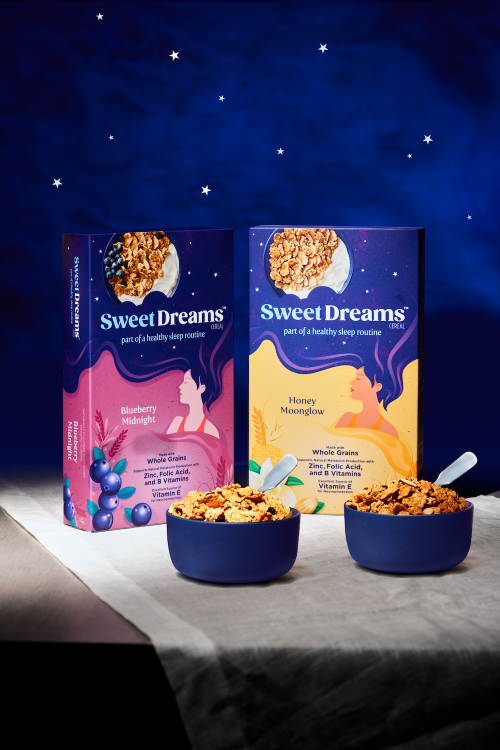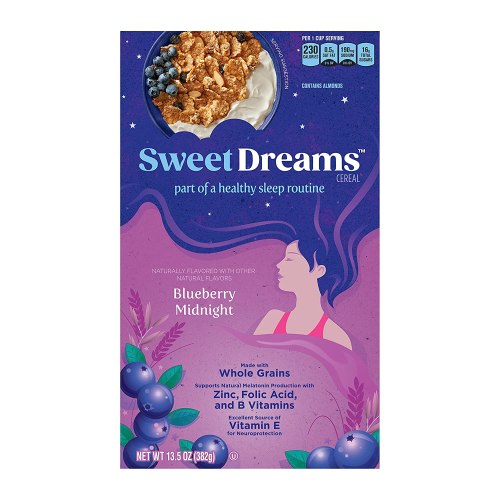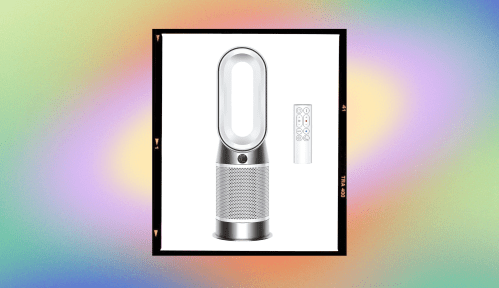Our editors independently select these products. Making a purchase through our links may earn Well+Good a commission
What Happened When I Tried Sweet Dreams Cereal, the First Box of Cereal Designed To Help You Sleep Better
I tried Sweet Dreams cereal, the first ready-to-eat cereal for healthy nighttime habits, and this was the effect it had on my bedtime routine.

Growing up, cereal was (IMO) the ideal meal for breakfast, lunch… and dinner. And I’ll admit, as a college kid on a limited budget with minimal cooking skills at the time, a bowl of Cinnamon Toast Crunch was a five-star meal. Nowadays, not much has changed (aside from my advanced degree in the culinary arts and experience working in professional restaurants): A comforting bowl of cereal still hits the spot.
Experts in This Article
Unfortunately, the other thing that isn’t quite the same as during my days in school is the fact that getting a good night’s rest seems to be harder than ever. Enter the all-new Sweet Dreams cereal from Post Consumer Brands (the makers of childhood staples like Honey Bunches of Oats and Fruity Pebbles).
Sweet Dreams is the first ready-to-eat cereal designed for fostering healthy nighttime habits. It’s made with sleep-boosting ingredients that support melatonin production, and claims to help you relax before bedtime while providing you with a nourishing snack or meal. Sounds dreamy enough, right?
To put it to the test, I tried integrating Sweet Dreams cereal into my nighttime routine for an entire week to see if it helped me count fewer sheep and catch more Z’s. Plus, a registered dietitian shares their perspective on the impact eating this sleepytime cereal may have on your rest.
Why Sweet Dreams cereal is said to be the dreamiest bedtime snack
The brand-new cereal comes in two delicious flavors—Blueberry Midnight and Honey Moonglow—which promise they’re packed with sleep-boosting ingredients. “Sweet Dreams helps to promote a healthy sleep routine through intentionally designed ingredients like whole grains, a nighttime herbal blend, and vitamins and minerals including zinc, folic acid, and B vitamins to support natural melatonin production,” Logan Sohn, senior brand manager of Post Consumer Brands, says.

Although folks can certainly eat cereal whenever they please (hi, it’s me!), Sweet Dreams is the first of its kind geared towards being integrated into your bedtime routine. “Our circadian rhythms—an important process for regulating sleep—love regularity. Establishing a consistent routine helps our brains learn when it is time to sleep,” Jennifer Kanady, PhD, Senior Clinical Development Lead for Sleep at Big Health, previously shared with Well+Good.
Those behind the innovative cereal brand obviously agree. “More than ever, consumers are looking to embrace acts of self-care. We often see this come to life through a relaxing nighttime routine that provides the basis for a good night’s sleep. This inspired us to create a product that not only satisfies that nighttime snack moment but also is part of a healthy sleep routine,” Sohn says.
“More than ever, consumers are looking to embrace acts of self-care. We often see this come to life through a relaxing nighttime routine that provides the basis for a good night’s sleep. This inspired us to create a product that not only satisfies that nighttime snack moment but also is part of a healthy sleep routine,” Sohn says.
Both flavors come equipped with notoriously calming herbal ingredients—chamomile and lavender—meant to soothe you as you unwind for the day. What’s more, this cereal contains the “big three” nutrients for boosting sleep quality: fiber (12 percent of your daily intake per cup), magnesium (with eight percent of your DV per cup, thanks to sleep-boosting ingredients like almonds), and melatonin (from vitamins that help promote its production, like zinc and B vitamins).
8 Stylish and Adjustable Office Chairs a Chiropractor Would Approve Of

ThirdLove Just Launched Bras That Help Balance Your Body Temperature—Here’s Why That’s a Game-Changer for Women in All Life Stages

These Are the Summer Essentials You Should Bring With You Every Time You Leave the House, According to a Derm and an RD

Sweet Dreams Blueberry Midnight Cereal — $13.00
Sweet Dreams Honey Moonglow Cereal — $5.00
How this sleep-boosting cereal impacted my nighttime routine
Guilty: I l-o-v-e cereal. So, the combination of actually being encouraged to eat it before bedtime and its potential sleep-boosting benefits was basically a match made in heaven. As described on the box, the cereal is intended to be consumed as part of a simple five-step bedtime routine consisting of: Relaxing with a bowl of cereal, keeping a set bedtime, switching off all devices an hour before sleep, taking 30 minutes out of your day to wind down, and practicing meditation or breathing exercises.
The cereal is intended to be consumed as part of a simple five-step bedtime routine consisting of: Relaxing with a bowl of cereal, keeping a set bedtime, switching off all devices an hour before sleep, taking 30 minutes out of your day to wind down, and practicing meditation or breathing exercises.
To stay true to Sweet Dreams’ five-step bedtime routine, I followed it religiously for a week straight. I consumed a bowl of the cereal (I alternated between the two flavors) about an hour before bedtime as a 7 p.m.“bedtime” snack—not as a replacement for my dinner—paired with my favorite unsweetened cashew milk by Elmhurst 1925 (another magnesium-rich rockstar). Then, I would do my best to head to bed by 8 p.m., disconnect from my devices, and take a few moments to meditate before hitting the hay.
For starters, the cereal tasted no different than any other “morning time” cereal on the market—this one is basically the love child of Honey Bunches of Oats and Special K. What sets Sweet Dreams apart, however, is that both of its flavors have ultra-subtle notes of lavender that were frankly very soothing to the palate. Though it tasted great, I’ll admit, the cereal was more like an after-meal dessert than the cup of unsweetened chamomile I usually sip on before bed.
That said, whenever I focus on maintaining a consistent sleep routine, I tend to reap the most restful benefits—which I think was mainly at play during my trial. Yes, I felt relaxed, and my tummy was happy thanks to the sweet treat, but I think it was primarily the combination of all the factors (namely, the routine) that helped make me feel more chilled out before bedtime. To definitively say that this cereal will single-handedly help you sleep is wishful thinking, in my opinion.
What a registered dietitian thinks about this cereal designed for sleep
I also spoke with Lauren Manaker, MS, RDN, LD, CLEC, CPT, a registered dietitian based in Charleston, who shared some thoughts regarding the formulation. “While ingredients like lavender and chamomile may help support sleep, we must remember that people need to consume a certain quantity of these ingredients to reap the sleep benefits,” Manaker says. “However, the quantity of these ingredients is not listed, and one can’t assume that enough of these ingredients are included in this cereal to offer a true benefit.”
What’s more, Manaker is apprehensive about the amount of sugar in the product. “One serving of these cereals has 13 grams of added sugar. Meanwhile, data shows that poor sleep quality was significantly related to higher added sugar intake,” she says. Although Manaker notes that some of the nutrients may support melatonin production, eating this cereal alone might not be the answer to your sleepless prayers.
Overall, according to Manaker, folks can—of course—eat this cereal, but if sleep is the goal, she recommends leaning on foods like walnuts, kiwis, a glass of milk, or chamomile tea for greater sleep-enhancing effects. But if you’re on the hunt for high-protein cereal, we’ve got you covered.
A dreamy lavender nightcap latte for your bedtime routine:








